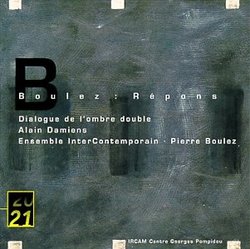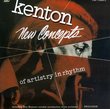| All Artists: Florent Boffard, Frederique Cambreling, Michel Cerutti, Daniel Ciampolini, Alain Damiens, Ensemble InterContemporain Title: Pierre Boulez: Répons / Dialogue de l'Ombre Double (20/21 series) Members Wishing: 0 Total Copies: 0 Label: Dg Imports Release Date: 4/13/1999 Album Type: Import Genre: Classical Styles: Chamber Music, Forms & Genres, Concertos, Symphonies Number of Discs: 1 SwapaCD Credits: 1 UPC: 028945760520 |
Search - Florent Boffard, Frederique Cambreling, Michel Cerutti :: Pierre Boulez: Répons / Dialogue de l'Ombre Double (20/21 series)
 | Florent Boffard, Frederique Cambreling, Michel Cerutti Pierre Boulez: Répons / Dialogue de l'Ombre Double (20/21 series) Genre: Classical
Written in the mid-1980s, Répons represents Pierre Boulez's first major work after his controversial tenure conducting the New York Philharmonic. It's also a demonstration of how live instruments could be used in conj... more » |
Larger Image |
CD DetailsSynopsis
Amazon.com essential recording Written in the mid-1980s, Répons represents Pierre Boulez's first major work after his controversial tenure conducting the New York Philharmonic. It's also a demonstration of how live instruments could be used in conjunction with computer-generated sound. He's been strangely hesitant to record it, which is even more mystifying the more one listens to this new DG release. It's one of the longest uninterrupted spans of music Boulez has ever composed. And while not as provocative as some of his early works, it's a marvel, a forest of sound that one wants to return to again and again. The live instruments (which include a Hungarian cimbalom) are dominated by richly textured percussion, which doesn't exactly make Répons unmelodic as beyond melody. Initially, the effects seem repetitive--alternating activity and stasis--but what later unfolds is a rich, gratifying, thematically unified exploration of sound with a meticulously planned exposition, development, and recapitulation. The companion piece, Dialogue de l'ombre double, is more modest and in some ways more charming, exploring spatial effects and pedal points between the live and computerized clarinet sound. Those interested in the future of music--both in terms of means and content--must hear this. --David Patrick Stearns Similarly Requested CDs
|
CD ReviewsOne of the landmark compositions of the 20th century Satoshi Akima | Sydney, Australia | 12/24/1999 (5 out of 5 stars) "I have literally waited years to hear Repons and am not disappointed. For years it had been talked about as landmark work from this, the arguably most profound of post-war composers. Boulez, as always succeeds in creating his own hynotic, jewelled, glittering, and almost mystical sound world. It is a sound world which has over the years matured to become even more subtle, more evocative, more obsessively fascinating. Through huge stretches of the work time seems to held in suspended animation only to be allowed to erupt forth from its former captivity with frenetic energy only moments later. Boulez's many enemies have always claimed that his music lacks the power to move the listener. But whoever really listens - yes, really listens to this work can only but be deeply moved, not by its wearing heart on sleeve, but by the sheer sense of boundless awe and wonder which the work so effortlessly evokes. As arpeggio is layered upon arpeggio, and amplified seemingly into infinity the sense of awe is like that of the starry night sky, for like it the impact is not one of a simple and singular emotive response but one that is somehow abstract - and thereby utterly impossible to convey with words. Indeed this is truly one of the artistic landmarks of the 20th century" A masterpiece and 20th century musical landmark. Nicholas Fox | 12/21/1999 (5 out of 5 stars) "Pierre Boulez is, with Stravinsky, Bartok, Schoenberg and Webern, one of the 5 greatest composers of the 20th century, and Repons is a towering masterpiece. You simply must hear it. His command of energy, color and structure is as moving and powerful as anything the past masters of previous centuries achieved, and in this work he opens up new fields of expression and technique that are simply astonishing. If you listen closely, you may be moved. Don't be put off. This is titanic art from a titanic mind. Needless to say, the performance is definitive." IRCAM's triumph finally recorded Christopher Culver | 07/14/2006 (5 out of 5 stars) "For several years after Pierre Boulez launched the Institut de Recherche et Coordination Acoustique/Musique (IRCAM) in Paris in 1977, critics wondered why he himself had nothing to show in the field of electronic music. But when he finally unveiled "Repons" in 1981, he showed himself a comfortable with the new technology, and many called the work his masterpiece. On this Deutsche Grammophon disc, part of the "20/21" series of new music recordings, we finally get a recording of "Repons", performed by the composer's own Ensemble Intercontemporain with Boulez himself conducting, along with "Dialogue de l'ombre double" for clarinet and electronics.
"Repons", here in its completed 1984 version, is a piece of massive proportions. It is scored not only for orchestra, but also for six soloists (two pianos, harp, vibraphone, xylophone & glockspiel, and cimbalom), and at the time of its unveiling the electronic manipulation of its sounds depended on the behemoth 4X computer. The work also requires a special distribution of the instruments in the concert hall, with six speakers surrounding the audience. It might sound complicated and eggheaded, but the musical structure Boulez builds out of these parts is ingenious and instantly likeable. The first of its ten sections is a simple chugging along by the orchestra, which sounds just like any ensemble effort. But then, this traditional music is torn asunder by the entrance of the soloists playing six simultaneous chords, amplified and bounced around the hall from speaker to speaker. Each of the soloists then plays individually an arpeggio, whose individual notes are captured by the electronics and themselves broken down into an arpeggio. Then, after a brief orchestral interlude, the soloists play arpeggios again, and this time the electronics generate an arpeggio of an arpeggio of arpeggio. What does this sound like? Just think lots of glittery, metallic sounds that are brilliantly chromatic. And that's just the beginning. Over the course of the work, Boulez displays such electronic wizardry as imposing one instrument's timbre over other sounds (Klangfarbemelodien), sustaining sounds into a shimmery continuum, and repeating certain sounds, with each appearance possessing a different alteration in pitch and rhythm. Finally, the piece has a clear dramatic arc, rare for Boulez, where we warm up slowly, hit a massive climax in the seventh section, and the gently cool down. "Dialogue de l'ombre double" for clarinet and electronics was written in 1985 for the sixtieth birthday of Luciano Berio. The "dialogue" of the title is between a live clarinet and a pre-recorded and electronically treated clarinet. The work again makes use of the performance space, with the live clarinettist lit while performing and the pre-recorded portions played in darkness and projected from speaker to speaker. The music is lyrical and musing, and the soft interplay of the two elements is quite soothing after the bustle of "Repons". Boulez's writing for clarinet has clearly matured after his earlier solo piece "Domaines", and here Alain Damiens expertly handles Boulez's virtuoso material. It's a pity that the rich spatial dimensions of the two works are collapsed here into a stereo recording--would that DG reissue this disc in surround sound. Nonetheless, a team at IRCAM developed special software for bringing the stereo sound as close as possible to the live experience, and this recording does indeed make for pleasurable listening. The liner notes are also relevatory, consisting of a description of the two pieces, an interview with Boulez, and IRCAM technician Andrew Gerzo's explanation of how the sound was adapted for stereo. Still, liner notes can only do so much, and if you really want to know more about the technology and theory behind "Repons", I'd recommend Dominique Jameux's PIERRE BOULEZ (Paris: Fayard/Sacem, 1984, with English translation Harvard University Press, 1991). All of Boulez's late works are exciting, so if you're unsure about this disc, check out "Sur Incises" or "...explosante-fixe..." (also on DG). But any Boulez fan should eventually encounter these brilliant electroacoustical works." |

 Track Listings (23) - Disc #1
Track Listings (23) - Disc #1





